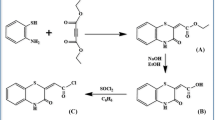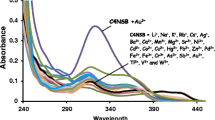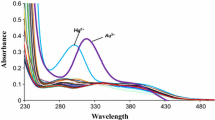Abstract
A novel quinoline-functionalized calix [4] arene derivative (Quin-Calix) has been successfully synthesized at partial cone conformation and duly characterized by using FTIR, 1H-NMR, 13C-NMR, ESI-MS and elemental analysis techniques. Moreover, the cation-binding property of the calix [4] arene derivative (Quin-Calix) has been investigated towards Cu2+, Ba2+, Cd2+, Co2+, Ni2+, Zn2+ and Fe3+ ions, and the recognition event monitored by UV-Vis absorption and fluorescence studies. The results indicated that Quin-Calix displays a remarkable affinity and selectivity only for Cu2+ ion. The binding constant and stoichiometry of the complex formed between Quin-Calix and Cu2+ ion have been also calculated from the fluorescence data. In addition, Stern-Vohmer equation has been used to elucidate the mechanism of quenching.











Similar content being viewed by others
Data Availability
The datasets generated or analyzed during the current study are available from the corresponding author on reasonable request.
References
Neri P, Sessler JL, Wang M-X (2016) Calixarenes and beyond. Springer
Kumar R, Sharma A, Singh H, Suating P, Kim HS, Sunwoo K, Shim I, Gibb BC, Kim JS (2019) Revisiting fluorescent calixarenes: from molecular sensors to smart materials. Chem Rev 119:9657–9721
Sayin S, Yilmaz M (2017) Synthesis of environmentally friendly, efficient and highly recyclable Lewis acid-type calix[4]arene catalysts containing flexible or bulky groups for the Mannich reaction. RSC Adv 7:10748–10756
Kim JS, Quang DT (2007) Calixarene-derived fluorescent probes. Chem Rev 107:3780–3799
Alizada M, Gul A, Oguz M, Kursunlu AN, Yilmaz M (2021) Ion sensing of sister sensors based-on calix[4]arene in aqueous medium and their bioimaging applications. Dyes Pigments 184:108741
Baldini L, Casnati A, Sansone F (2020) Multivalent and multifunctional Calixarenes in bionanotechnology. Eur J Org Chem:5056–5069
Shinkai S (1993) Calixarenes – the third generation of supramolecules. Tetrahedron 49:8933–8968
Razuvayeva Y, Kashapov R, Zakharova L (2020) Calixarene-based pure and mixed assemblies for biomedical applications. Supramol Chem 32:178–206
Akkus GU, Memon S, Sezgin M, Yilmaz M (2009) Synthesis of calix(aza)crown and its oligomeric analogue for the extraction of selected metal cations and dichromate anions. Clean Soil Air Water 37:109–114
Erdemir S, Malkondu S (2020) Calix[4]arene based a NIR-fluorescent sensor with an enhanced stokes shift for the real-time visualization of Zn(II) in living cells. Sensors Actuators B Chem 306:127574
Bhatti AA, Oguz M, Memon S, Yilmaz M (2017) Dual fluorescence response of newly synthesized naphthalene appended calix[4]arene derivative towards Cu2+ and I−. J Fluoresc 27:263–270
Elmas SNK, Ozen F, Koran K, Yilmaz I, Gorgulu AO, Erdemir S (2017) Coumarin based highly selective “off-on-off” type novel fluorescent sensor for Cu2+ and S2− in aqueous solution. J Fluoresc 27:463–471
Barja BC, Bari SE, Marchi MC, Iglesias FL, Bernardi M (2011) Luminescent Eu (III) hybrid sensors for in situ copper detection. Sensors Actuators B Chem 158:214–222
Quiroga-Campano C, Gómez-Machuca H, Moris S, Pessoa-Mahana H, Jullian C, Saitz C (2021) Synthesis of calix[4]arenes bearing thiosemicarbazone moieties with naphthalene groups: highly selective turn off/on fluorescent sensor for Cu(II) recognition. J Mol Struc 1225:129125
Sahin O, Akceylan E (2014) A phenanthrene-based calix[4]arene as a fluorescent sensor for Cu2+ and F-. Tetrahedron 70:6944–6950
Oguz M, Bhatti AA, Karakurt S, Aktas M, Yilmaz M (2017) New water soluble Hg2+ selective fluorescent calix[4]arenes: synthesis and application in living cells imaging. Spectrochim Acta Part A Mol Biomol Spec 171:340–345
Li Y, Hou J, Zhou H, Jia M, Chen S, Huang H, Zhang L, Yu C (2020) A fluorescence sensor array based on perylene probe monomer-excimer emission transition for the highly efficient differential sensing of metal ions and drinking waters. Sensors Actuators B Chem 319:128212
Dong W, Wang R, Gong X, Liang W, Fan L, Song S, Dong C (2020) A ratiometric and far-red fluorescence “off-on” sensor for sequential determination of copper(II) and L-histidine based on FRET system between N-acetyl-L-cysteine-capped AuNCs and N,S,P co-doped carbon dots. Microchim Acta 187:299
Li FJ, Sa RJ (2019) The formation of Cu3,4(TCA), made TCA complex a highly selective probe for Cu2+ detection: a TDDFT study. J Mater Chem C 7:2443–2456
Xu YF, Hou YH, Wang YT, Wang YF, Li T, Song C, Wei NN, Wang QF (2019) Sensitive and selective detection of Cu2+ ions based on fluorescent Ag nanoparticles synthesized by r-phycoerythrin from marine algae porphyra yezoensis. Ecotoxicol Environ Saf 168:356–362
Qiu S, Wei Y, Tu T, Xiang J, Zhang D, Chen Q, Luo L, Lin Z (2020) Triazole-stabilized fluorescence sensor for highly selective detection of copper in tea and animal feed. Food Chem 317:1264342
Gutsche CD, Iqbal M (1990) p-tert-Butylcalix[4]arene. Org Synt 68:234–237
Iwamoto K, Araki K, Shinkai S (1991) Conformations and structures of tetra- 0 -alkyl-p -tert -butylcalix4]arenes. How is the conformation of calix[4]arenes immobilized?. J Org Chem 56:4955–4962
Chawla HM, Pant N, Srivastava B, Upreti S (2006) Convenient direct synthesis of bisformylated calix[4]arenes via ipso substitution. Org Lett 8:2237–2240
Patra S, Paul P (2009) Synthesis, characterization, electrochemistry and ion-binding studies of ruthenium (II) bipyridine receptor molecules containing calix [4] arene-azacrown as ionophore. Dalton Trans 40:8683–8695
Modi K, Panchal U, Dey S, Patel C, Kongor A, Pandya HA, Jain VK (2016) Thiacalix[4]arene-tetra-(quinoline-8- sulfonate): a sensitive and selective fluorescent sensor for Co (II). J Fluoresc 26:1729–1736
Sayin S, Akoz E, Yilmaz M (2014) Enhanced catalysis and enantioselective resolutionof racemic naproxen methyl ester by lipase encapsulated within iron oxidenanoparticles coated with calix[8]arene valeric acid complexes. Org Biomol Chem 12:6634–6642
Gutsche CD (1989) In: Stoddart JF (ed) Monograph in supramolecular chemistry: calixarenes, vol 1. The Royal Society of Chemistry, Cambridge, London
Kumar M, Bhalla V, Dhir A, Babu JN (2010) A Ni2+ selective chemosensor based on partial cone conformation of calix[4]arene. Dalton Trans 39:10116–10121
Hu X, Zhang X, Song H, He C, Bao Y, Tang Q, Duan C (2012) A novel copper(II) complex-based fluorescence probe for nitric oxide detecting and imaging. Tetrahedron 68:8371–8375
Durgadas CV, Sharma CP, Sreenivasan K (2011) Fluorescent gold clusters as nanosensors for copper ions in live cells. Analyst 136:933–940
Sahin O (2013) Synthesis and spectral properties of pyrene based calix[4]arene. J Mol Struct 1041:175–182
Shanmugaraj K, Ilanchelian M (2016) A “turn-off” fluorescent sensor for the selective and sensitive detection of copper(ii) ions using lysozyme stabilized gold nanoclusters. RSC Adv 6:54518–54524
Valdebenito S, Zapata-Torres G, Lemp E, Zanocco AL (2015) Experimental and theoretical studies of the photophysics of 7-amino-3-phenyl-2H-benzo[b] [1,4]oxazin-2-one in homogeneous solvents and b-cyclodextrin aqueous solutions. Afinidad 72:569
Renny JS, Tomasevich LL, Tallmadge EH, Collum DB (2013) Method of continuous variations: applications of job plots to the study of molecular associations in organometallic chemistry. Angew Chem Int Ed 52:11998–12013
Murphy CB, Zhang Y, Troxler T, Ferry V, Martin JJ, Jones WE (2004) Probing Förster and Dexter energy-transfer mechanisms in fluorescent conjugated polymer chemosensors. J Phys Chem B 108:1537–1543
Bhatt KD, Makwana BA, Vyas DJ, Mishra DR, Jain VK (2014) Selective recognition by novel calix system: ICT based chemosensor for metal ions. J Lumin 146:450–457
Funding
The author thanks the Scientific and Technological Research Council of Turkey (TUBITAK Grant Number 117Z402) for financial support of the main part of this work.
Author information
Authors and Affiliations
Contributions
Not applicable.
Corresponding author
Ethics declarations
Conflicts of Interest/Competing Interests
The author states that there are no known competing economic interests or personal relationships that may affect the work reported in this paper.
Ethics Approval
Not applicable.
Additional information
Publisher’s Note
Springer Nature remains neutral with regard to jurisdictional claims in published maps and institutional affiliations.
Supplementary Information
ESM 1
(DOC 2160 kb)
Rights and permissions
About this article
Cite this article
Sayin, S. Synthesis of New Quinoline-Conjugated Calixarene as a Fluorescent Sensor for Selective Determination of Cu2+ Ion. J Fluoresc 31, 1143–1151 (2021). https://doi.org/10.1007/s10895-021-02749-6
Received:
Accepted:
Published:
Issue Date:
DOI: https://doi.org/10.1007/s10895-021-02749-6




